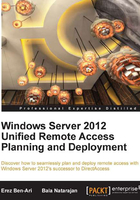
Chapter 2. Planning a Unified Remote Access Deployment
Unified Remote Access comes in many shapes and forms, allowing you to configure it to fit your organization's needs and abilities perfectly. Smaller organizations may prefer a simplified deployment that requires less moving parts, while larger organizations may need to deploy multiple clusters of servers that span the globe. Organizations with very stringent security policies may need additional components to come into play, such as Network Access Protection (NAP) or Two Factor Authentication (2FA). To accommodate your needs perfectly, your first task will be to plan the deployment and get acquainted with the various deployment scenarios. In this chapter, we will discuss:
- Server requirements and placement
- Basic scenarios
- PKI
- GPO
- Client platforms (and unsupported clients)
- Cloud scenarios
- Advanced scenarios (NAP, OTP, Arrays, Multi-geographic, and Forced tunneling)
- How much can my server handle?
Let's start our planning by getting to know the pre-requisites for deployment of this role.